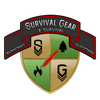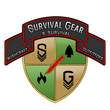The History of Bushcraft Knives

The term “bushcraft knife” is relatively new. It dates back to the 1980s when Mors Kochanski, a Canadian survival expert, coined the term in his book, Bushcraft: Outdoor Skills and Wilderness Survival.
Kochanski’s Bushcraft is essentially an instruction manual on surviving in the Great North Woods in true bushranger style-- living off the land with the absolute minimum of equipment.
But these knives were around long before Kochanski published his work and dubbed these tools with their current name.
Evolution of the Survival Knife
The survival knife’s history began and its story continues in the same place: the wilderness. These tools have existed in some form or another since the dawn of time. Cavemen forged knives out of shards of flint, obsidian, and other rock material.
Though their knives were forged from different material, cavemen likely used these knives for many of the same reasons that modern bushrangers use steel blade bushcraft knives: hunting, trapping, skinning and cleaning wild game, woodcutting, and carving.
Fast forward thousands of years from the days of cavemen to the 1830s, when the notorious Jim Bowie revolutionized the survival knife. This infamous pioneer is responsible for designing the Bowie Knife, a widely recognizable fixed-blade knife that touts a curved shank anywhere between five and twelve inches in length. This curved fixed-blade style is found in many bushcraft knives today.
Unfortunately, this revamped style of knife did not become popularized until many years later. Throughout the 19th century, hunters and military men wielded butcher knives.
It was not until the 20th century when survival knives underwent another metamorphosis. Webster L. Marble introduced heavier blades, cross-guards, and pommels to formulate a more modern design. By the time WWII came around, survival knives replaced butcher knives as the standard for US soldiers.
Survival knives were also issued in the Vietnam War to troops and continue to be an option soldiers can select to carry even now.
Today, bushcraft knives are the preferred tool of survivalists and bushrangers looking to follow in the footsteps of Mors Kochanski. For these modern survival knives, the minimum blade length falls somewhere between seven and ten inches.
The ideal length for most bushrangers is estimated to be nine inches. This size allows the knife to function as both a hatchet and machete, depending on the needs the bushranger is looking to meet in a given moment.
Most bushcraft knives have the curve designed by Jim Bowie as well as the pommel and guard introduced by Webster L. Marble. Blades vary in weight, and thankfully are no longer made of cavemen material.
As technology continues to advance, one can only guess as to what the evolution of these knives will look like in the future.
Final Thoughts
If you haven’t already, I strongly recommend reading Kochanski’s Bushcraft. Not only does Kochanski thoroughly explain the uses of bushcraft knives, he also discusses proper safety guidelines for these tools.
He goes over appropriate treatment of cuts, and how to prevent them in the first place. This is vital information that every bushranger should carry with them.







Leave a comment